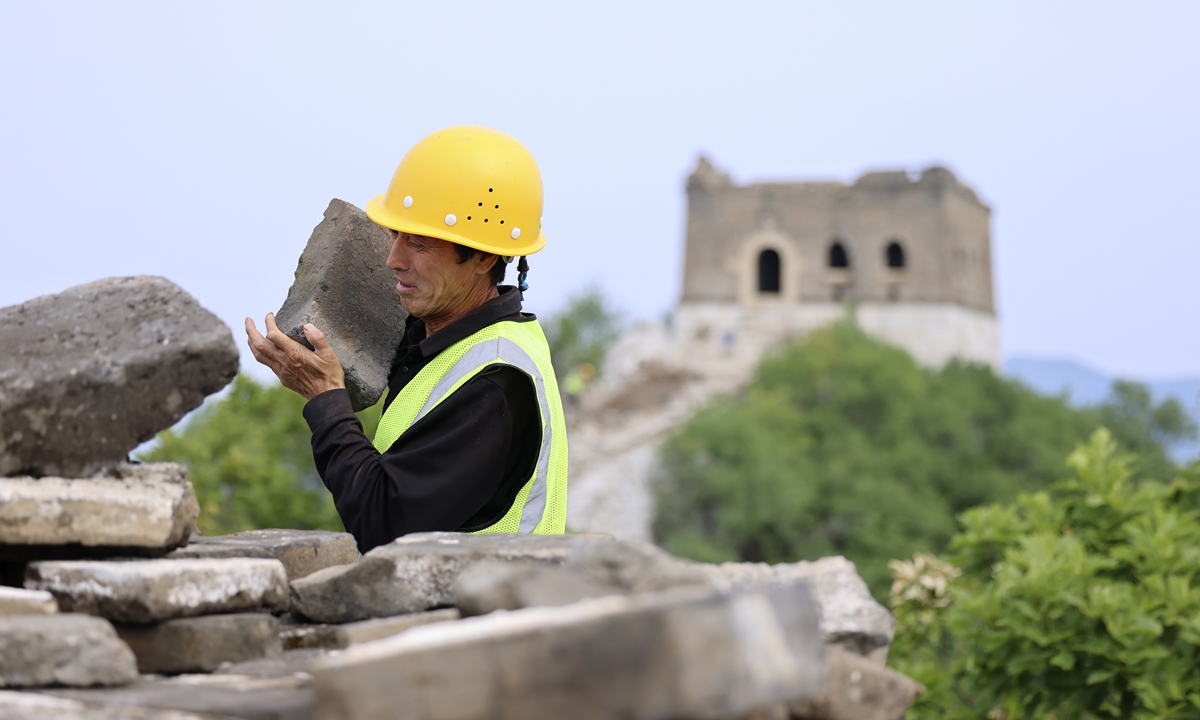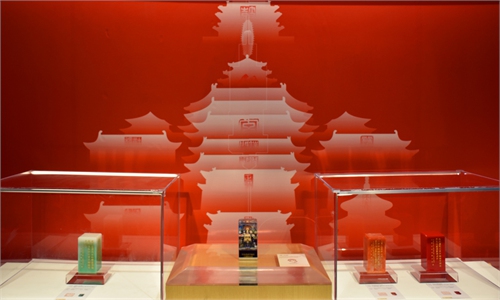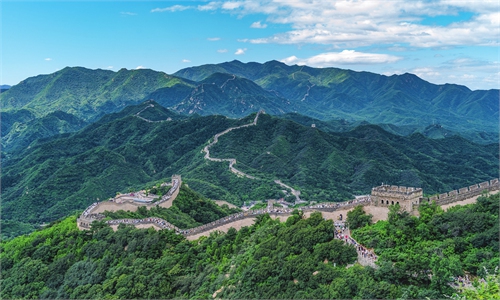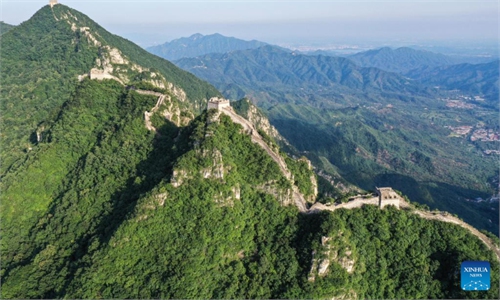ARTS / CULTURE & LEISURE
Military remains, beast-shaped decorations found during latest restoration of Ming Dynasty Great Wall in Beijing
Same heritage, new strategies

A worker carries a brick at the Jiankou section of the Great Wall in Beijing. Photo: IC
Including rare discoveries like carbonized grains and ancient coins, more than 170 artifacts dating back to the Ming Dynasty (1368-1644) have been unearthed at the Jiankou section of the Great Wall in Beijing. Such gems were discovered thanks to an on-site archaeological project that is set to conclude at the end of August.The implementation of archaeology at this time was meant to assist in the fifth phase of the Jiankou Great Wall's restoration. By adopting the "excavating while restoring" approach for the first time, it is one of the examples that highlights China's growing creativity in protecting the Great Wall in modern times.
Pivotal works
In April, archaeological works started at the Jiankou section of the Great Wall two months before the on-site restoration work began. Such an arrangement was "sensible" since it "gives immediate rescue to the yet-to-be-discovered Great Wall relics," archaeologist Wang Meng told the Global Times.
Three types of relics were "rescued" in the months after the project kicked off. There were architectural components such as a beast-shaped decoration, military remains like the Frankish machines, a type of small cannons, and ancient everyday items like coins.
Despite their small size, the unearthed carbonized plant seeds were important discoveries showing human interactions with the Great Wall.
Shang Heng, head of the archaeological project, told the Global Times that some of these remnants have already been identified as grains. According to the condition in which the relics were discovered, Shang said that they show ancient garrisoned soldiers' "eating habits and their outdoor barbecue-like cooking style."
"Such archaeological discoveries have added more interesting narratives to Great Wall culture. These narratives bring the ancient heritage to life and closer to us," remarked Shang, who is also a researcher at the Beijing Institute of Archaeology.
What made the Jiankou archaeological project special was its interdisciplinary nature, in which the archaeological process was integrated with studies of plants, animals, the environment, and digital technology into the archaeological process.
The incorporation of digital technology was a highlight. More than 8,000 photos, along with techniques such as unmanned aerial vehicle (UAV) measuring, and 3D modeling were carried out on-site to establish a comprehensive digital record of the Jiankou section of the Great Wall.
Shang Jinyu, an expert responsible for the digital project, told the Global Times that digital works are pivotal to the entire restoration project, since the flexibility of machines like the UAV can help human beings detect "some neglected and extremely fragile parts that need to be repaired."
Similar to the digital strategy used at the Jiankou section of the Great Wall, Li Dan, a representative from the Administration Office of the Badaling Great Wall, told the Global Times that a total of 18 patrol routes for UAVs have been allocated along the Badaling section of the Great Wall to help with safety management while also boosting local tourism.
"Making a cultural heritage site come alive is a difficult task that demands not only the modern inputs like digital technologies, but also the societal power and the love of ordinary people," Xu Shuming, a cultural sociologist, told the Global Times.
Global attention
Themed "Love My China, Repair My Great Wall," a campaign encouraging societal-level sponsorships to protect the Great Wall was launched in Beijing 40 years ago.
The initiative was jointly launched by the media in Beijing at the time and was ground-breaking since it attracted individuals, enterprises, and social groups from different fields like art, entertainment, and sport to contribute to repairing the Great Wall.
The initiative was successful in preserving the Badaling section of the Great Wall, Li Dan told the Global Times. According to Li, between 1984 and 1994, it received donations from 100,000 organizations and groups, including international contributors.
Xu, an expert, told the Global Times that other than engaging the Chinese community, the campaign has left another legacy that has encouraged the world to join in the conservation of the Great Wall. During the "Love My China, Repair My Great Wall" campaign, for example, organizations from Pakistan, Greece, the US, and 24 other countries and regions also made active contributions, collectively raising tens of millions of yuan.
"It is thanks to such a well-established historic tradition of engaging the international community in the protection of the Great Wall that this cultural heritage can be enjoyed by the rest of the world, especially the younger generations," Xu remarked.
A brief scroll through international social media platforms such as X (formerly Twitter), YouTube, and TikTok, reveals a myriad of content shared by netizens related to the Great Wall, indicating that the world heritage site is perceived as a "marvelous spectacle" globally.
The Badaling section of the Great Wall has received nearly 200 million domestic and international visitors, including over 500 heads of state, government leaders, and numerous globally recognized figures, according to the data from the Badaling Great Wall Management Office. These influential figures shared their admiration for the cultural heritage site in their journeys.
To further promote the international influence of the cultural brand of China, various international exchange activities have been held on the Great Wall in recent years. The 2021 Belt and Road Great Wall International Folk Culture and Arts Festival kicked off in Qinhuangdao, North China's Hebei Province, presenting a grand cultural feast to audiences both at home and abroad. Moreover, the torch for the Beijing 2022 Winter Olympics was ceremonially transferred at the Badaling section of the Great Wall in Beijing's Yanqing district, capturing the attention of the world.



